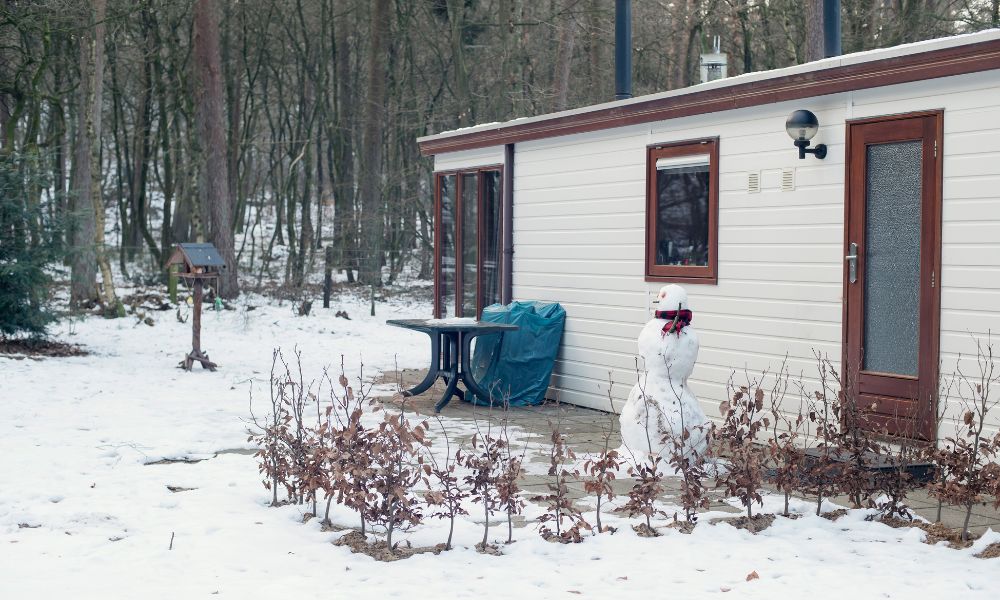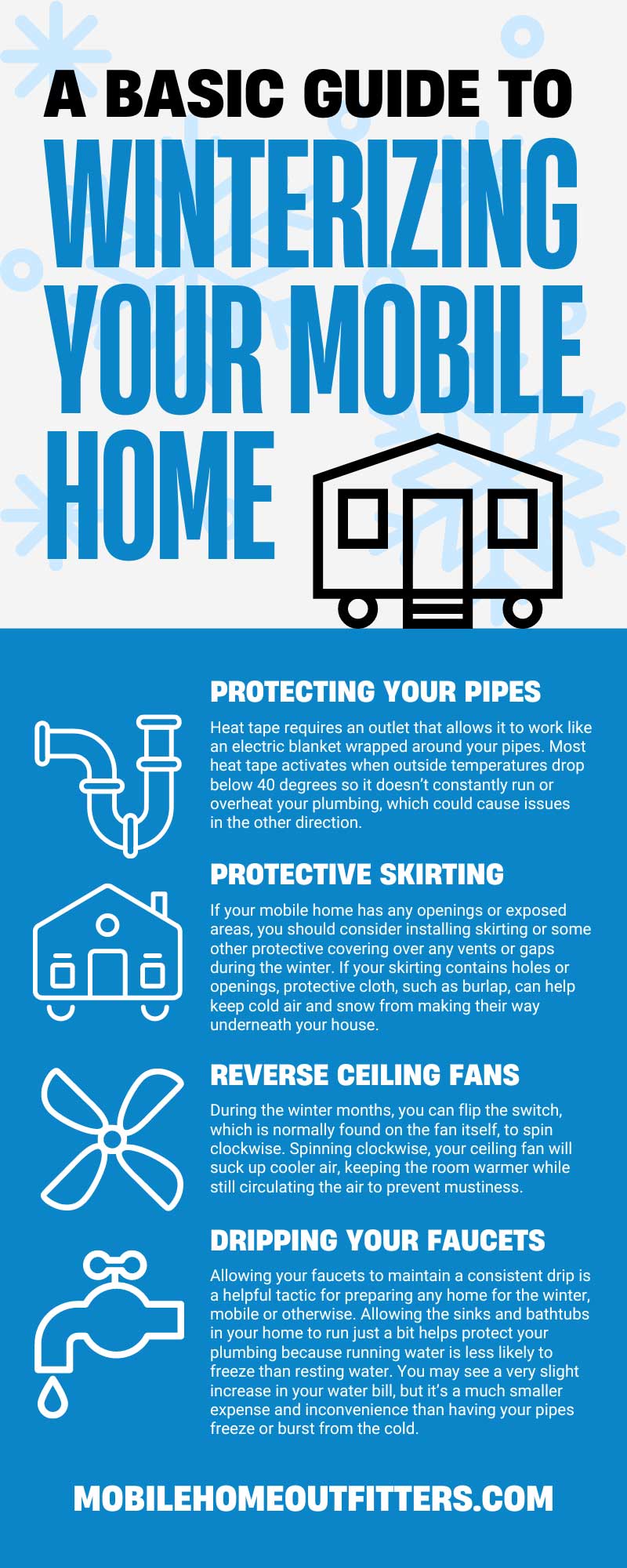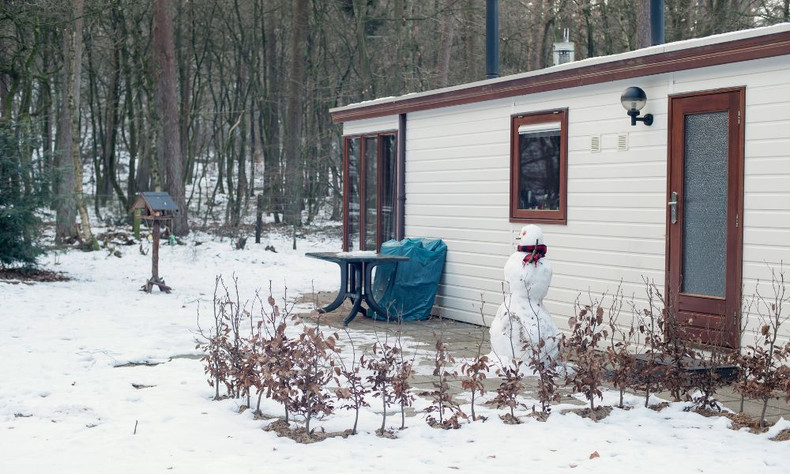
With shorter days and colder temperatures outside, it’s essential to think about preparing your home for winter. There are many different steps you can take and projects to do to ensure your home is warm, safe, and secure throughout the colder months. Mobile Home Outfitters is here with a helpful guide to winterizing your mobile home that you can use as a checklist to get everything ready to go.
Protecting Your Pipes
One of the most significant risks for mobile homes in colder climates is freezing temperatures damaging the pipes. We recommend getting under the base of your home and carefully inspecting your plumbing system. Applying heat tape to your pipes helps insulate them and keeps things warm throughout the winter.
Heat tape requires an outlet that allows it to work like an electric blanket wrapped around your pipes. Most heat tape activates when outside temperatures drop below 40 degrees so it doesn’t constantly run or overheat your plumbing, which could cause issues in the other direction.
Protective Skirting
It’s always a good idea to have adequate skirting around the exterior of your home, but it’s especially beneficial in winter. Skirting provides additional protection to the underside of your home by insulating it from colder temperatures. If you live in an area with heavy snowfall, skirting keeps snow out, allowing you to get underneath your home with less hassle.
If your mobile home has any openings or exposed areas, you should consider installing skirting or some other protective covering over any vents or gaps during the winter. If your skirting contains holes or openings, protective cloth, such as burlap, can help keep cold air and snow from making their way underneath your house.
Reverse Ceiling Fans
Sometimes, the smallest change can have a big impact on the comfort of our homes. Most ceiling fans have two settings that adjust the direction in which the blades spin. Most people keep their fans on a summer setting, where the blades spin counterclockwise to help blow the air down and create a cool breeze.
During the winter months, you can flip the switch, which is normally found on the fan itself, to spin clockwise. Spinning clockwise, your ceiling fan will suck up cooler air, keeping the room warmer while still circulating the air to prevent mustiness.
Blocking Gaps and Cracks
The main way that cold air gets into a home is through small cracks, typically around the doorframe and windows. Before it gets too cold, it’s a good idea to carefully inspect and monitor these areas for any small cracks and fill them. Using a caulk gun or weatherstripping is an efficient and inexpensive way to fill gaps large enough for cold air to seep through and protect the interior of your home during the colder months.
Aside from doors and windows, there are other areas you may want to fill in with a caulking gun. It’s a good idea to inspect any exhaust fans, like those found in the kitchen or bathroom, as these frequently connect the interior and exterior of the home and may have small cracks along the edges. Lighting fixtures in the ceiling are also good areas to inspect to see if any noticeable gaps allow for cold air to get inside.
Preventing Potential Accidents
A significant step in our guide to winterizing your mobile home is ensuring that residents and guests are safe from accidents or injuries. Because many mobile homes are elevated above the ground, it’s common for homes to have wooden or fiberglass stairs. If your home has steps or a ramp leading up to a front porch or backyard deck, they may be much slipperier in the winter months due to snowfall.
To slip-proof the steps leading up to your porch or deck, we suggest putting down an anti-slip adhesive tape or strip to increase traction. Your steps should also have a railing, and we recommend keeping two points of contact to steady yourself at all times when ascending or descending.
Dripping Your Faucets
Allowing your faucets to maintain a consistent drip is a helpful tactic for preparing any home for the winter, mobile or otherwise. Allowing the sinks and bathtubs in your home to run just a bit helps protect your plumbing because running water is less likely to freeze than resting water. You may see a very slight increase in your water bill, but it’s a much smaller expense and inconvenience than having your pipes freeze or burst from the cold.
Keep the Heat Running
It may seem like an environmentally friendly idea to turn off the heat when your home doesn’t seem particularly chilly. But constantly adjusting your thermostat may damage your home. The ideal temperature will fluctuate depending on your house’s age, insulation, and materials.
We recommend keeping your home, at the lowest, between 55 and 60 degrees Fahrenheit. Maintaining a consistent temperature helps keep your home comfortable and safe from winter weather throughout the cold months. So, find a comfortable temperature to set your thermostat for the winter, and only make minimal adjustments as necessary without completely shutting it down.
Distribute the Heat
Do you ever open a closet or cabinet and feel that sudden chill? When you have certain doors or drawers shut, these areas don’t warm up with other areas of your home, which may throw off the circulation.
Go through your home and allow closet doors or cabinets to remain slightly open, which gives the heat a chance to flow into the areas you typically shut off. When places that don’t normally have exposure to your ventilation system receive warm air through circulation, it helps create a more balanced temperature in your home.
For more information about how to prepare your house for the winter and other maintenance tips, reach out to Mobile Home Outfitters. We can help you find the best mobile home skirting kit for your residence with our handy skirting calculator. Contact us anytime to speak to a staff member for any additional questions, comments, or concerns.


